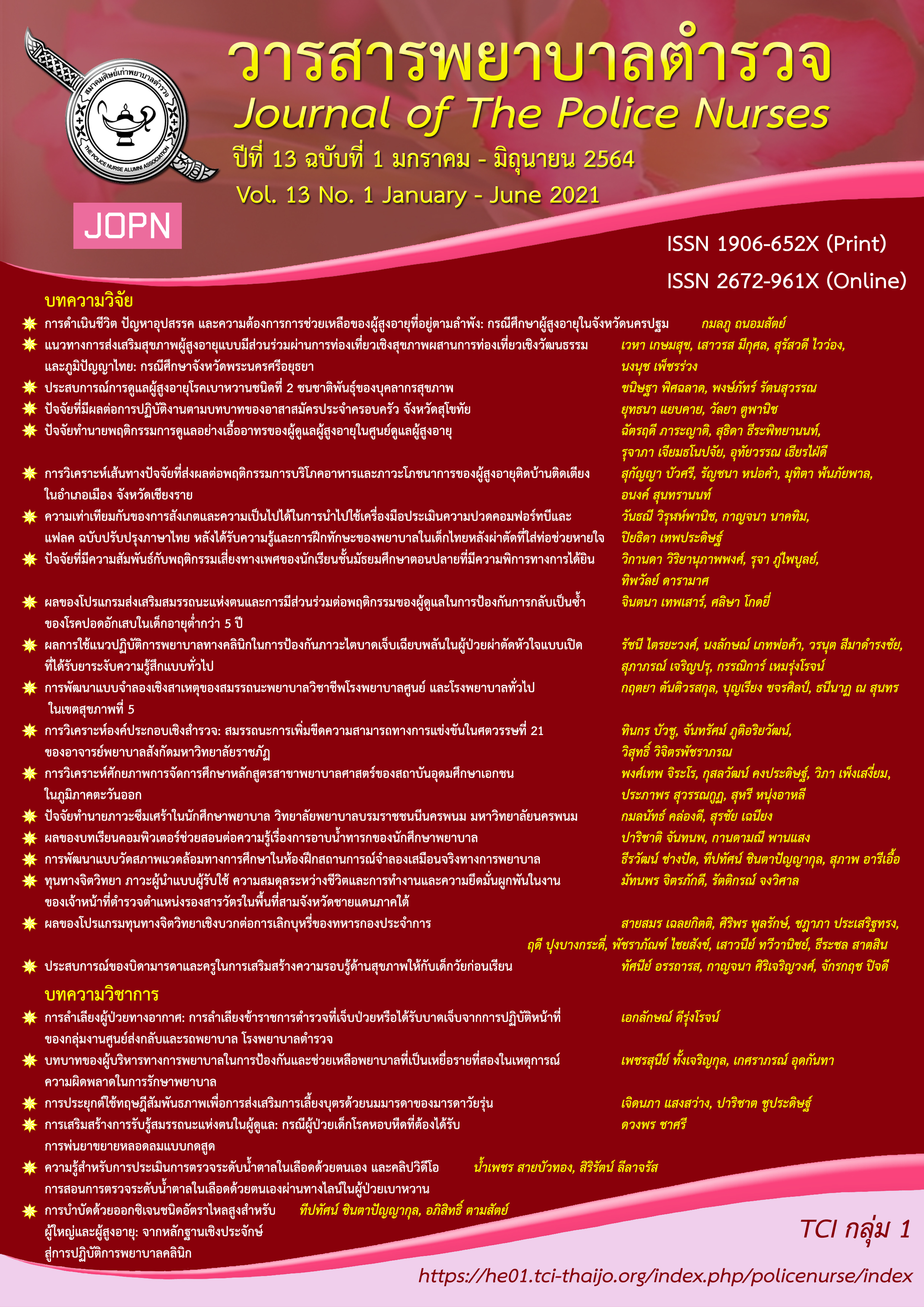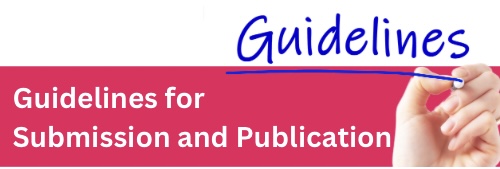FACTORS RELATED TO SEXUAL RISK BEHAVIORS AMONG HIGH SCHOOL STUDENTS WITH HEARING IMPAIRMENT
Keywords:
sexual risk behaviors, high school students, hearing impairmentAbstract
This cross-sectional study was designed to examine sexual risk behaviors among high school students with hearing impairment, and explore the relationship between predisposing factors, enabling factors, reinforcing factors, and sexual risk behaviors among high school students with hearing impairment in accordance with Precede-Proceed Model. The subjects were 92 high school students with hearing impairment who were studying in Mathayomsuksa 4-6 at School for the Deaf located in the southern region of Thailand. The samples were selected by purposive sampling based on the inclusion criteria. Data were collected by using 7 questionnaires as follows: 1) personal information, 2) attitudes towards sexuality, 3) perceived self-efficacy to avoid sexual risk behaviors, 4) sexual media accessibility, consisting of 4.1) channels of accessing sexual media and 4.2) convenience in accessing sexual media, 5) behaviors leading to sexual intercourse, 6) influence of friends, and 7) sexual risk behaviors. The 2nd – 7th questionnaires had the content validity test, resulting in a 1.00 CVI value. The Cronbach’s alpha coefficients of instruments were .72, .71, .75, .80, .77, .72 and .83, respectively. The data were analyzed by using descriptive statistics, namely, frequency, percentage, mean, and standard deviation. The relationship was analyzed by using Spearman’s Rank Correlation, and Chi-square test.
The findings of this study revealed that the samples had the lowest mean scores of sexual risk behaviors (M = 1.58, SD = .70). Factors that were positively related to sexual risk behaviors with a .05 level of statistical significance included the following: 1) attitudes towards sexuality, 2) channels of accessing sexual media, 3) convenience in accessing sexual media, 4) behaviors leading to sexual intercourse, and 5) influence of friends (rS = .218, rS = .316, rS = .236, rS = .615, and rS = .445, respectively). However, age, gender, school record, pocket money from parents, and perceived self-efficacy to avoid sexual risk behaviors were not related to sexual risk behaviors (p > .05) Therefore, community nurses, public health technical officers, and teachers could utilize the results of this study to develop guidelines or programs for preventing or mitigating sexual risk behaviors among high school students with hearing impairment in the future.
Downloads
References
Apakupakul, N. (2013). Effectiveness of health education in human immunodeficiency virus (HIV)/ acquired immune deficiency syndrome (AIDS) via a dual video for deaf students and normal students. Sonklanagarind Medical Journal, 31(2), 71-81.
Bartlett, K. E. (2015). Sources of sexual knowledge and associated outcomes in a deaf population (Doctoral dissertation). Texas Woman's University, USA.
Best, J. W., & Kuhn, J. V. (2003). Research in education (9th ed.). Boston: Aflyn and Bacon.
Bowler, G., & Weinraub, M. (2018). The SAGE encyclopedia of lifespan human development.
Boonya, R. (2008). Sign language: Language of the deaf. Journal of Ratchasuda college for Research and development of persons with disabilities, 4(1), 77-94.
Butcharoen, W. (2011). Factors related to sexual risk behavior among Thai secondary school students (Master of science, public health nursing). Faculty of Public Health, Mahidol University.
Chaisamdaeng, P. (2019). Effects of the computer game “Kid ... Think” program on attitudes, subjective norms, perceived behavioral control, an intention to not express sexual risk behaviors of deaf students in high schools (Master of nursing science program, pediatric nursing). Ramathibodi School of Nursing, Faculty of Medicine Ramathibodi Hospital, Mahidol University.
Chartphahol, W. (2016). Factors related to sexual risk behaviors students in secondary school in Nakhon Ratchasima Province. 4th Rajabhat University National and International Research and Academic Conference, 128-137. Retrieved from http://dspace.bru.ac.th/xmlui/handle/123456789/2091
Cohen, J. (1988). Statistical power analysis for the behavioral sciences. New York. NY: Academic.
Cohen, J. (1992). Quantitative methods in psychology: A power primer. Psychological Bulletin, 112, 1155-1159.
Eiambhu, B. (2011). Factors related to sexual risk behaviors of students in opportunity extended schools, Nakorn Prathom province (Master of Science, health education and behavioral science). Faculty of Graduate Studies, Mahidol University, Nakhon Pathom.
Green, L. W., & Kreuter, M. W. (2005). Health program planning: An educational and ecological approach. New York, NY: McGraw-Hill Higher Education, 4.
Heiman, E., Haynes, S., & McKee, M. (2015). Sexual health behaviors of deaf American Sign Language (ASL) users. Disability and health journal, 8(4), 579-585.
Heuttel, K. L., & Rothstein, W. G. (2001). HIV/AIDS knowledge and information sources among deaf and hearing college students. American annals of the deaf, 280-286.
Hongprayoon, S. (2015). Developing News Program on Internet Protocol Television (IPTV) for Deaf People. Suthiparithat, 29(90), 291-312.
Job, J. (2004). Factors involved in the ineffective dissemination of sexuality information to individuals who are deaf or hard of hearing. American Annals of the Deaf, 149(3), 264-273.
Kaewviengdach, C., & Hirunwatthanakul, P. (2016). Factors associated with sexual risk behaviours among secondary school students in Nakhon Phanom Province. Journal of The Royal Thai Army Nurses, 17(3), 168-177.
Kaiser Family Foundation. (2003). National survey of adolescents and young adults: Sexual health knowledge, attitudes and experiences.
Kaewpan, W., Kalampakorn,S., & Pichyapinnyo, P. (2018). Factors related to alcohol consumption behavior among teenage pregnancy in Bangkok metropolitan. Journal of the Office of DPC 7 Khon Kaen, 25(3), 56-66
Kittisuksathit, S., Madarat, N., Sitthi, W., Richter, K., & Kanungsukkasem, U. (2011). I don’t wonna be a mom: Bumpy road of Thai teen mom. Bangkok: Octoberprint Press. Retrieved from https://www.teenpath.net/data/r-research/00008/tpfile/00001.pdf
Khunkum, W. (2009). Factors affecting sexual behavior mattayomsuksa of 2 students, Ubon Ratchathani Province (Master of public health, health promotion). Ubon Ratchathani Rajabhat University, Ubon Ratchathani.
Pimchanok. (2015). When you don't know what gender you are? Retrieved from http://www.thaihealth.or.th/Content/27443
Pimkrajang, P. (2017). The study on the way of using online media of the people with hearing loss (Master of communication arts, communication arts). Faculty of Communication Arts, Dhurakijpundit University, Bangkok.
Piyagul, P. (2016). Sexual risk behavior among vocational school students, Samutprakan province (Master of public health, health promotion management). Faculty of Public Health, Thammasat University, Pathumthani.
Punmeekij, N. (2016). Factors affecting sexual risk behaviors among female lower secondary school students in Pattaya city (Thesis of Master of Nursing Science, Community Nurse Practitioner). Faculty of Nursing Burapha University, Chonburi.
Ritcharoon, P. (2007). Principles of educational measurement and evaluation. Bangkok: houses of Kermit.
Rusinga, O. (2012). Perceptions of deaf youth about their vulnerability to sexual and reproductive health problems in Masvingo District, Zimbabwe. African Journal of Reproductive Health, 16(2), 271-282.
Schiffman, L. G., & Kanuk, L. L. (1994). Consumer behavior. Englewood Cliffs (NJ): Prentice-Hall.
Sirisreetreerux, R., Apakupakul, N., Srichaichana, H., & Thaichareon, N. (2012). Knowledge on risk behavior and opinion on HIV/AIDS infection among the students and teachers in the school for the deafs, a pilot study in Lower Southern of Thailand. Thai AIDS Journal, 24(3), 133-146.
Sitthirangsan, W. (2019). Life for the deaf many people do not know yet. Retrieved from https://www.pptvhd36.com/news/113540
Songpracha, P., Maharka, P., & Srisurakul, T. (2020). The environment supporting students’ learning in school for the deaf. Journal of Ratchasuda College, Research and Development of Persons with Disabilities, 16(1), 46-58.
Suebvises, P. (2016). Qualitative research of persons with disabilities: Experiences of Researcher in the Occupational Training Centers. Journal Of Ratchasuda College for Research and Development of Persons with Disabilities, 2(2). Retrieved from http://s://www.rs.mahidol.ac.th/rsjournal/vol.2/v.2-2-002.pdf
Thai Health Promotion Foundation. (2019). Youth have a disability. Yet, their sexual and reproductive health is up and fully functional. Retrieved from https://www.p4teen.com/content/detail/83
Thai Health Promotion Foundation. (2019). Video media in increasing sex education knowledge for students with Hearing Impairment. Retrieved from https://www.thaihealth.or.th/Content/50453
The Secretariat of the Senate Bureau of Committree 3. (2016). Social commission's study report of social commission, children's affairs, youth, female, the elderly, the disabled and the disadvantaged national legislative assembly refer to providing education for the deaf: Production and service of sign language interpretations. Retrieved from https://library2.parliament.go.th/giventake/content_nla2557/d122359-02.pdf
Downloads
Published
How to Cite
Issue
Section
License
ผลงานที่ได้ตีพิมพ์แล้วจะเป็นลิขสิทธิ์ของวารสารพยาบาลตำรวจ















